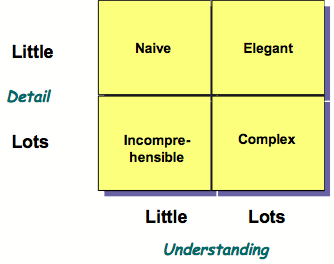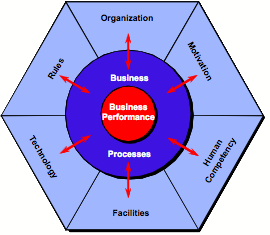BPM Points of View
"A different point of view is simply
the view from a place where you're not."~ From a series of posters sponsored by HSBC
in Heathrow Airport
This is the first in a series of columns where I will be writing about the challenges and opportunities that come with the multi-domain, multi-dimensional, and multi-functional nature of process management. As a BPM consultant, I work with clients confronting the thorny and challenging aspects of process management as they work to achieve the full potential of BPM, instead of continuing a pattern of sub-optimization. All are dealing with an interconnected set of challenges. Internally, however, different groups tend to see the issues from their own limited perspective. These clients are finding, as am I, that there is still a lot of confusion about BPM among their subordinates, associates, and managers. To make matters worse, many of the players are unaware of the differences that are creating the confusion.
A related problem is that individual stakeholders advocate strongly for their position and, more often than not, employ strikingly different approaches in methodology, techniques, diagramming notations, or tools, to name a few. These conflicts, plus the general confusion created by the lack of a common vocabulary and a consistent encompassing methodology, often result in heated arguments over what should be done, not to mention how the processes and their related attributes should be described.
Experience also shows that many differing uni-dimensional views of process thinking are rampant — a condition that encourages short-sighted solutions at the expense of a more encompassing view of the problems and the optimal solutions. For the most part, no solution designed for a single domain can solve the problems of the Enterprise. Indeed, accommodating narrow perspectives is contrary to the very essence of BPM, which is to realize the goals of the Enterprise by providing broader, richer solutions.
Avoiding complexity, whenever possible, is a desirable goal, but simple solutions are only useful if they are elegant; that is, if they are well grounded in a comprehensive understanding of the Enterprise. Otherwise, in their naiveté, they can do more harm than good. Likewise, approaches that create incomprehensible detail for detail's sake without a comprehensive understanding of the Enterprise should be shunned. Figure 1 shows the range of possibilities that we must navigate and warns of the danger of advocating a position while not fully understanding its ramifications on all domains.

Figure 1. The Range of Possibilities
My purpose in this series is to provide a different and broader set of Points of View and, hopefully, to ensure that BPM becomes more unified across all dimensions and functions in the Enterprise, assuring its integrity.
Multiple Points of View (POV)
In his book, Seven Habits of Highly Effective People, Steven Covey's first principle of being highly effective is to "start with the end in mind." Notwithstanding this sage advice, the principle also sheds light on why BPM advocates often get into trouble, since one person's "end" frequently differs from that of another. Further, none of the ends necessarily contributes to the all-important "end" of the Enterprise — the customers it serves.
Looking at any problem from the end of the transformation journey — while simultaneously looking up to the beginning — provides focus, assuming that all who are along for the ride are headed to the same destination in the same vehicle. When everyone has his own destination in mind, the journey can (and usually does) take many wrong turns, arriving at a destination no one intended.
Let's take the example of the IT developer whose POV seeks to clarify and put in place a set of implementable specifications for what he or she must build. Frequently, this POV reflects little or no knowledge, interest, or incentive to deal with others' needs or concerns, lest they jeopardize his or her personal mission and performance evaluation. This is just one of many, arguably valid, POVs. We must focus on the overall goals of the Enterprise, balancing and reconciling all of the POVs and using the right tools in the right place at the right time, to create a solution that supports the Enterprise POV. Our job, as mature BPM professionals, is to ensure integrity among all results to be delivered and all factors to be managed, thus serving the whole Enterprise — not just the individual parts of the Enterprise.
The Hexagon in Figure 2 represents some of the key aspects of process-aligned capability required to deliver business performance. No one hexagonal segment is the one and only important consideration. All of these interrelated considerations, moreover, must be aligned with one another to create holistic solutions that deliver complete business results, even if some parts are not at their own peak, individually.
Figure 2. Key Aspects of Process-aligned Capability
In addition to the cross-domain alignment required, we must also ensure that full traceability exists up and down any decomposition or composition within each domain. This means, for example, process models or IT specs must be connected to the higher-level model from which they are derived and to the business motivation that drives their design. The key to success in any single domain is to have it aligned in all BPM domains concurrently. This requires us to think more broadly and to consider multiple points of view with a common 'end' in mind.
Points Of View in other Realms
Last year my daughter, who was studying social documentary film in college, produced a film that showed four different points of view. It showed the same situation through the eyes of concerned parties, each of which would lead the viewer to draw differing conclusions and take conflicting, devastating actions. However, the real story lay in the amalgam of all of these perspectives; it was not adequately reflected by any single one. Many successful story tellers and communicators have used this approach to demonstrate that no one perspective can provide a comprehensive picture of any situation. Films, such as the Oscar-winning Crash, have shown multiple racial and social POVs that, when taken together, provide a richer and more complete understanding than one limited viewpoint. Another example from film is Clint Eastwood's dual effort to illuminate the WWII battle of Iwo Jima. The U.S. POV was portrayed in Flags of Our Fathers and a Japanese POV in Letters from Iwo Jima. Where does the reality lie? It is probably in neither one. But this illustrates the challenge in having perspectives that are not reconciled.
If you have read Shakespeare or attended a production, you will know that ignoring, misunderstanding, or being unaware of others' perspectives is at the center of conflict in many of Shakespeare's works. For me, a recent performance of Romeo and Juliet brought home the tragic consequences of not comprehending differing POVs. Because of narrow perspectives, the principals ended up dead. (I hope I didn't spoil the ending for you.) Anyone in a personal relationship knows that differing POVs frequently lead to arguments and hard feelings, or worse, if not acknowledged. When all sides are considered and dealt with rationally, the result is usually more acceptable and the relationship sustainable.
Points of View and BPM
There is a military expression that says "The map is not the landscape." This adage was clearly illustrated when I visited 'Ordnance Survey' in Southampton UK in 2004. Ordnance Survey is Great Britain's national mapping agency. It was formed over 200 years ago to support British military operations in the field.
Once I arrived, I entered a large rotunda and saw many maps of Britain around the walls. I was puzzled until I got closer and saw that each had a different POV. There were maps of rainfall, population, roads, health, and many other perspectives of interest to one group or another, but they all presented an outline of the same place — Britain. Each map held great significance to a specific group of stakeholders, but none was actually Britain itself — just one of a number of simplifying abstractions which, when taken together, provided a richer understanding of that island.
I have never worked with any organization where the realization was made so clear that the Process Architecture map is not the Organization chart.
Upcoming POV Articles
In future columns, I will address various aspects of process management that lead us to differing perceptions. My challenge will be to get everyone on the same page, sharing their competing POVs in a variety of domains and bringing them together with common understanding. I will address the challenge of BPM and Enterprise Architecture, the levels of BPM from Enterprise, Process, and Implementation perspectives, competing external stakeholder needs and wants, Enterprise versus Functional strategic planning, modeling techniques and notations, measurement perspectives, analysis techniques and notations, innovation and continuous improvement differences, knowledge management and competencies, management, and governance. Along the way I will look forward to your feedback and suggestions.
# # #
About our Contributor:
Online Interactive Training Series
In response to a great many requests, Business Rule Solutions now offers at-a-distance learning options. No travel, no backlogs, no hassles. Same great instructors, but with schedules, content and pricing designed to meet the special needs of busy professionals.











How to Define Business Terms in Plain English: A Primer
How to Use DecisionSpeak™ and Question Charts (Q-Charts™)
Decision Tables - A Primer: How to Use TableSpeak™
Tabulation of Lists in RuleSpeak®: A Primer - Using "The Following" Clause
Business Agility Manifesto
Business Rules Manifesto
Business Motivation Model
Decision Vocabulary
[Download]
[Download]
Semantics of Business Vocabulary and Business Rules